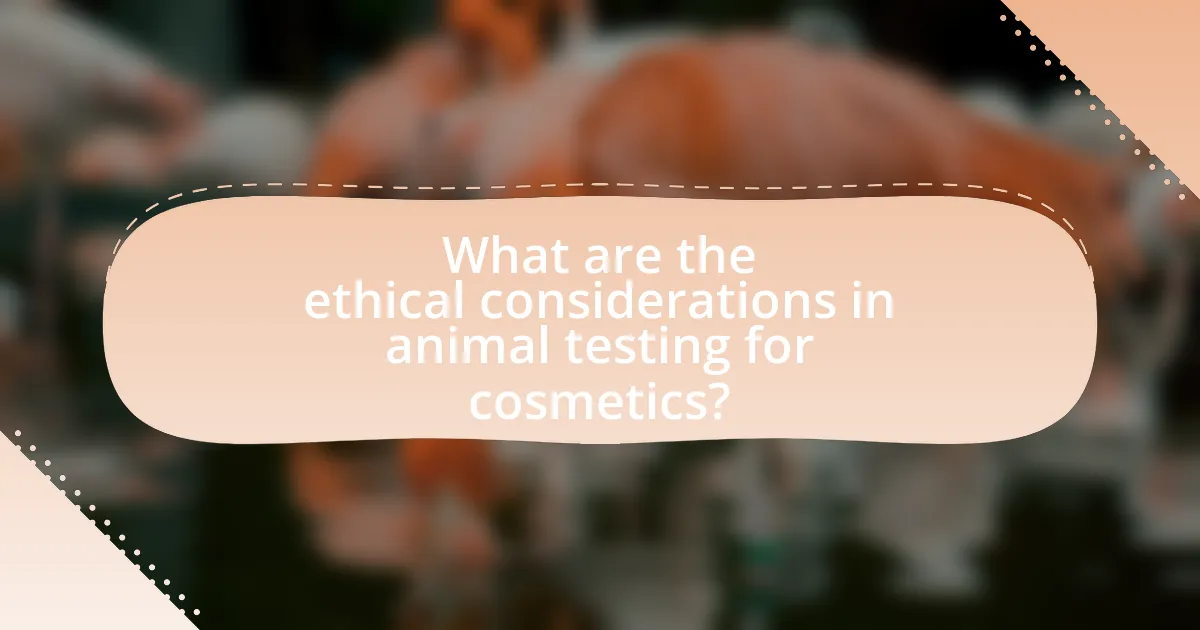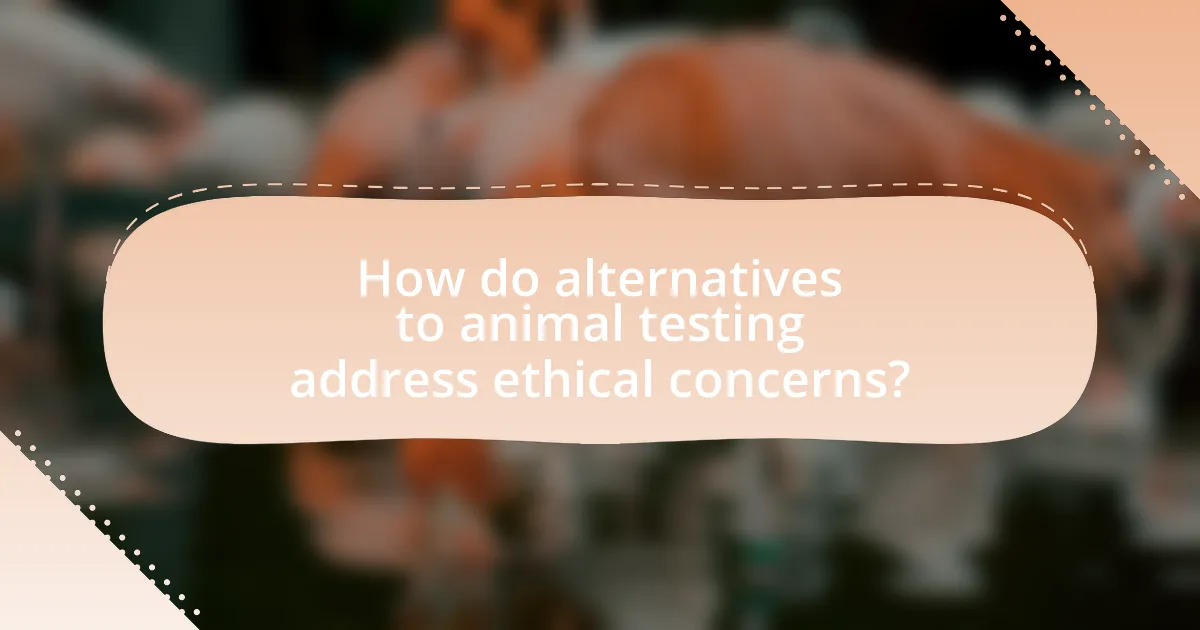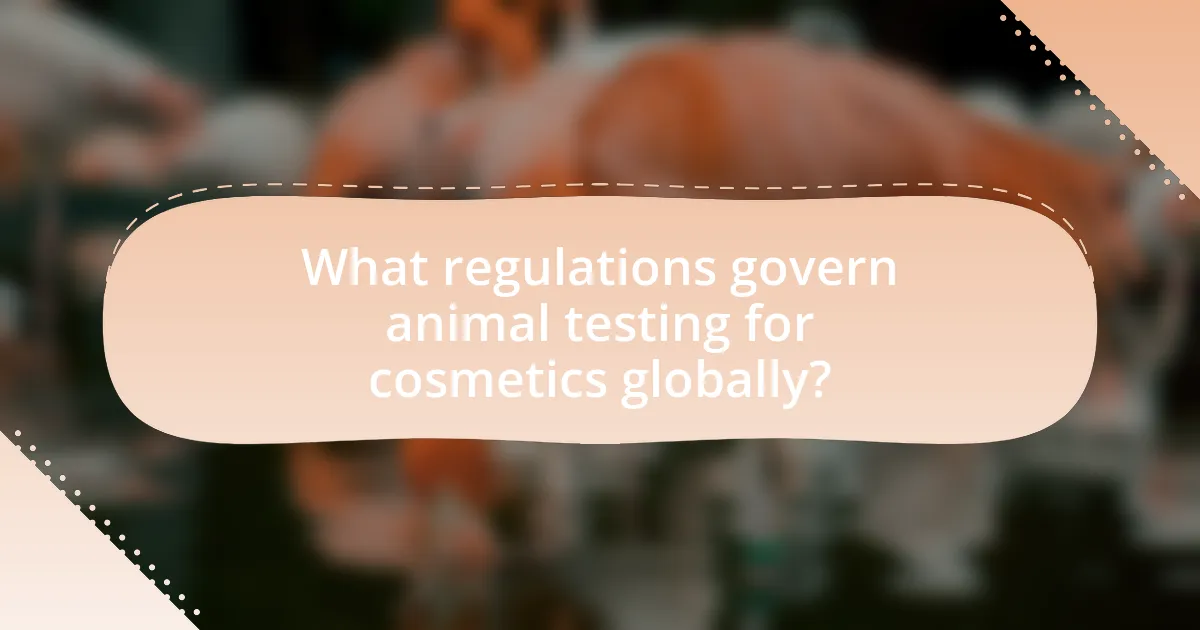The article examines the ethical considerations surrounding animal testing in the cosmetics industry, focusing on animal welfare, the necessity of testing, and the availability of alternative methods. It highlights the significant ethical dilemmas posed by animal testing, including the pain and suffering inflicted on animals, and discusses the regulatory landscape, particularly the European Union’s ban on animal testing for cosmetics. The article also explores the arguments for and against animal testing, the impact of consumer preferences on brand reputation, and the effectiveness of alternative testing methods such as in vitro testing and computer modeling. Additionally, it addresses the challenges faced by small cosmetics companies in complying with regulations and the emerging trends towards ethical practices in the industry.

What are the ethical considerations in animal testing for cosmetics?
The ethical considerations in animal testing for cosmetics primarily revolve around animal welfare, the necessity of testing, and the availability of alternative methods. Animal welfare concerns arise from the potential for pain, suffering, and distress experienced by animals subjected to testing procedures. The necessity of testing is questioned, as many argue that cosmetic products do not require the same level of safety assurance as pharmaceuticals. Furthermore, advancements in alternative testing methods, such as in vitro testing and computer modeling, challenge the justification for animal testing. According to the Humane Society International, over 115 million animals are used in experiments globally each year, highlighting the scale of the ethical dilemma. The European Union has banned animal testing for cosmetics since 2013, reflecting a significant shift towards prioritizing ethical considerations in this field.
Why is animal testing used in the cosmetics industry?
Animal testing is used in the cosmetics industry primarily to ensure the safety and efficacy of products before they reach consumers. This practice aims to identify potential adverse effects and toxic reactions that could occur from the use of cosmetic ingredients. Historically, regulatory agencies in various countries have mandated animal testing as a means to protect human health, leading to its widespread adoption in the industry. For instance, the U.S. Food and Drug Administration (FDA) has guidelines that recommend safety testing, which often includes animal studies, to evaluate the potential risks associated with cosmetic products.
What types of tests are commonly performed on animals for cosmetics?
Common types of tests performed on animals for cosmetics include skin irritation tests, eye irritation tests, and acute toxicity tests. Skin irritation tests assess the potential of a cosmetic product to cause skin damage, often using rabbits or guinea pigs. Eye irritation tests evaluate the likelihood of a product causing eye damage, typically conducted on rabbits. Acute toxicity tests determine the lethal dose of a substance, often involving various animal species. These tests have been widely criticized for ethical reasons, leading to a push for alternative methods.
How do regulatory requirements influence animal testing practices?
Regulatory requirements significantly influence animal testing practices by establishing legal frameworks that dictate when and how animal testing must be conducted. These regulations, such as the European Union’s REACH (Registration, Evaluation, Authorisation and Restriction of Chemicals) and the U.S. Animal Welfare Act, mandate that companies demonstrate the safety of cosmetic products through specific testing protocols, often requiring animal testing as a last resort. For instance, the EU’s ban on animal testing for cosmetics has led to the development and adoption of alternative testing methods, thereby reshaping industry practices to comply with ethical standards while ensuring consumer safety.
What ethical dilemmas arise from animal testing for cosmetics?
Animal testing for cosmetics raises significant ethical dilemmas, primarily concerning the welfare and rights of animals. The practice often subjects animals to painful procedures, confinement, and potential death, which raises questions about the moral justification of causing suffering for cosmetic purposes. According to the Humane Society International, over 500,000 animals are used annually in cosmetic testing worldwide, highlighting the scale of this ethical issue. Furthermore, the lack of regulatory requirements for alternatives in many regions exacerbates the dilemma, as companies may prioritize profit over humane treatment. This situation prompts a broader ethical debate about the necessity of animal testing in an era where alternative methods, such as in vitro testing and computer modeling, are increasingly viable.
How do animal welfare concerns impact public perception of cosmetics brands?
Animal welfare concerns significantly influence public perception of cosmetics brands by driving consumer preferences towards cruelty-free products. Research indicates that 64% of consumers are willing to pay more for products that do not involve animal testing, reflecting a strong ethical stance on animal rights. Brands that are transparent about their animal testing policies and actively promote cruelty-free practices tend to enjoy higher customer loyalty and positive brand image. Conversely, brands associated with animal testing often face backlash, leading to negative publicity and decreased sales. This shift in consumer behavior underscores the importance of ethical considerations in the cosmetics industry, as companies that prioritize animal welfare can enhance their reputation and market share.
What are the arguments for and against animal testing in cosmetics?
Arguments for animal testing in cosmetics include the belief that it ensures product safety for human use, as animal models can provide insights into potential adverse reactions and toxicological effects. Proponents argue that animal testing has historically contributed to significant medical advancements and the development of safe products, citing that the FDA requires safety data for new cosmetics, which often involves animal testing.
Arguments against animal testing in cosmetics center on ethical concerns regarding animal welfare and the belief that it is inhumane to subject animals to testing for non-essential products. Critics argue that alternative methods, such as in vitro testing and computer modeling, can provide reliable safety data without harming animals. Additionally, many countries have implemented bans or restrictions on animal testing for cosmetics, reflecting a growing societal consensus against the practice.

How do alternatives to animal testing address ethical concerns?
Alternatives to animal testing address ethical concerns by providing methods that do not involve the use of sentient beings, thereby reducing animal suffering. Techniques such as in vitro testing, computer modeling, and human cell-based assays allow researchers to evaluate the safety and efficacy of cosmetic products without harming animals. For instance, the European Union’s ban on animal testing for cosmetics, implemented in 2013, has led to the adoption of these alternative methods, demonstrating a commitment to ethical standards in product safety. Additionally, studies have shown that in vitro methods can yield results that are often more relevant to human biology than traditional animal models, further supporting the ethical shift away from animal testing.
What are the most common alternatives to animal testing in cosmetics?
The most common alternatives to animal testing in cosmetics include in vitro testing, computer modeling, and human volunteer studies. In vitro testing utilizes human cells and tissues to assess the safety and efficacy of cosmetic products, providing relevant biological data without the use of animals. Computer modeling, or in silico methods, employs algorithms and simulations to predict how substances will behave in biological systems, significantly reducing the need for animal testing. Human volunteer studies involve testing products on willing participants, which can yield direct insights into human reactions. These methods are supported by regulatory frameworks and scientific research, demonstrating their effectiveness and reliability in ensuring cosmetic safety without animal use.
How effective are in vitro methods compared to animal testing?
In vitro methods are generally considered less effective than animal testing for predicting human responses in complex biological systems. While in vitro techniques can provide valuable insights into cellular and molecular mechanisms, they often lack the physiological context that animal models offer, which is crucial for understanding systemic effects and interactions within an organism. Studies have shown that in vitro tests can miss important toxicological effects that only manifest in whole organisms, leading to potential safety concerns when applied to cosmetics. For instance, a review published in the journal “Toxicology in Vitro” highlighted that in vitro assays often fail to accurately predict the skin irritation potential of cosmetic ingredients compared to animal models, which can assess the overall biological response.
What role does computer modeling play in reducing animal testing?
Computer modeling significantly reduces animal testing by simulating biological processes and predicting the effects of substances without the need for live subjects. These models utilize algorithms and data from existing biological research to assess toxicity, efficacy, and safety of cosmetic ingredients. For instance, the European Union’s REACH regulation encourages the use of in silico methods, which have been shown to decrease the reliance on animal testing by up to 30% in certain assessments. This shift not only aligns with ethical considerations but also accelerates the development process for cosmetics, making it more efficient and humane.
Why is it important to adopt alternative testing methods?
Adopting alternative testing methods is important because they reduce the ethical concerns associated with animal testing in cosmetics. Traditional animal testing often subjects animals to pain and suffering, raising significant ethical issues. According to the European Union’s Cosmetics Regulation, animal testing for cosmetics has been banned since 2013, reflecting a societal shift towards more humane practices. Alternative methods, such as in vitro testing and computer modeling, not only align with ethical standards but also can provide more relevant data for human safety, as they utilize human cells and tissues. This shift is supported by research from the National Institutes of Health, which indicates that alternative methods can be more predictive of human responses, thus enhancing consumer safety while respecting animal welfare.
How do alternatives contribute to ethical consumerism?
Alternatives contribute to ethical consumerism by providing cruelty-free options that reduce reliance on animal testing in the cosmetics industry. These alternatives, such as in vitro testing and computer modeling, allow companies to assess product safety without harming animals, aligning with consumer demand for ethical practices. Research indicates that 70% of consumers are willing to pay more for products that do not involve animal testing, demonstrating a clear market preference for ethical alternatives. This shift not only promotes humane treatment of animals but also encourages innovation in product development, further supporting ethical consumerism.
What are the challenges in implementing alternative testing methods?
The challenges in implementing alternative testing methods include regulatory acceptance, validation processes, and technological limitations. Regulatory acceptance is often hindered by existing frameworks that prioritize traditional animal testing, making it difficult for alternative methods to gain approval. Validation processes for new testing methods can be lengthy and costly, requiring extensive data to demonstrate reliability and relevance. Additionally, technological limitations may restrict the development of alternatives that can accurately replicate complex biological responses observed in animal models. These challenges collectively impede the widespread adoption of alternative testing methods in the cosmetics industry.

What regulations govern animal testing for cosmetics globally?
Regulations governing animal testing for cosmetics globally include the European Union’s Cosmetics Regulation (EC) No. 1223/2009, which prohibits animal testing for cosmetic products and their ingredients. This regulation is supported by the EU’s REACH (Registration, Evaluation, Authorisation and Restriction of Chemicals) legislation, which emphasizes the reduction of animal testing. In addition, countries like India, Israel, and Norway have implemented similar bans on animal testing for cosmetics. The United States does not have a federal ban but allows states like California to enforce their own restrictions. These regulations reflect a growing global trend towards ethical considerations in cosmetic testing, aiming to protect animal welfare while promoting alternative testing methods.
How do different countries approach animal testing regulations?
Different countries have varying approaches to animal testing regulations, reflecting their ethical standards and legal frameworks. For instance, the European Union has implemented a comprehensive ban on animal testing for cosmetics since 2013, mandating that all cosmetic products must be free from animal testing. In contrast, the United States allows animal testing for cosmetics, although it is not required by law, leading to a mix of practices among companies. Additionally, countries like India and Israel have enacted bans on animal testing for cosmetics, aligning with global trends towards cruelty-free practices. These regulatory differences highlight the diverse ethical considerations and legal requirements surrounding animal testing in the cosmetics industry.
What are the key differences between the EU and US regulations on animal testing?
The key differences between EU and US regulations on animal testing are primarily centered around the prohibition of animal testing for cosmetics in the EU, while the US allows it under certain conditions. The European Union has implemented a comprehensive ban on animal testing for cosmetics since 2013, which includes both the testing of finished products and the ingredients used in them. In contrast, the United States does not have a federal ban on animal testing for cosmetics; instead, it follows the guidelines set by the Food and Drug Administration (FDA), which permits animal testing if deemed necessary for safety assessments. Additionally, the EU emphasizes the use of alternative methods and requires companies to demonstrate that they have explored non-animal testing options, whereas the US regulations do not mandate such a requirement. This fundamental difference highlights the EU’s stricter stance on animal welfare in the cosmetics industry compared to the more permissive approach taken by the US.
How do international agreements influence national policies on animal testing?
International agreements significantly influence national policies on animal testing by establishing frameworks that promote ethical standards and regulatory harmonization. For instance, the European Union’s REACH regulation and the OECD guidelines encourage member countries to adopt alternatives to animal testing, leading to legislative changes that prioritize non-animal methods. These agreements often include commitments to reduce animal testing and enhance transparency, compelling nations to align their domestic laws with international ethical standards. Consequently, countries that are signatories to such agreements may implement stricter regulations on animal testing, reflecting the collective ethical stance of the international community.
What impact do regulations have on the cosmetics industry?
Regulations significantly impact the cosmetics industry by enforcing standards that govern product safety, labeling, and testing methods. These regulations, such as the European Union’s Cosmetics Regulation (EC) No. 1223/2009, prohibit animal testing for cosmetic products and ingredients, compelling companies to adopt alternative testing methods. This shift not only influences product development and innovation but also affects market access, as compliance with stringent regulations is necessary for selling products in various regions. Consequently, companies that fail to adhere to these regulations may face legal penalties, product recalls, and damage to their reputation, highlighting the critical role of regulatory frameworks in shaping industry practices.
How do compliance costs affect small cosmetics companies?
Compliance costs significantly impact small cosmetics companies by straining their financial resources and limiting their market competitiveness. These companies often face high expenses related to regulatory compliance, including testing, documentation, and certification processes mandated by laws such as the European Union’s Cosmetics Regulation. For instance, small businesses may spend up to 20% of their revenue on compliance-related activities, which can divert funds from product development and marketing. This financial burden can hinder their ability to innovate and scale, ultimately affecting their sustainability in a market dominated by larger corporations that can absorb these costs more easily.
What trends are emerging in response to changing regulations?
Emerging trends in response to changing regulations in animal testing for cosmetics include the increased adoption of alternative testing methods, such as in vitro testing and computer modeling. These alternatives are gaining traction as regulatory bodies, like the European Union, implement stricter bans on animal testing, prompting companies to seek compliant and ethical solutions. For instance, the EU’s 2013 ban on animal testing for cosmetics has led to a 30% increase in the use of non-animal testing methods among cosmetic manufacturers, demonstrating a significant shift towards ethical practices in the industry.
What can consumers do to support ethical practices in cosmetics?
Consumers can support ethical practices in cosmetics by choosing products that are certified cruelty-free and avoiding brands that test on animals. Research indicates that the global cruelty-free cosmetics market is growing, reflecting consumer demand for ethical alternatives. According to a 2021 survey by the Humane Society International, 70% of consumers are willing to pay more for cruelty-free products, demonstrating a clear preference for ethical practices. By actively seeking out and purchasing from brands that prioritize animal welfare, consumers can drive change in the cosmetics industry and encourage more companies to adopt humane practices.